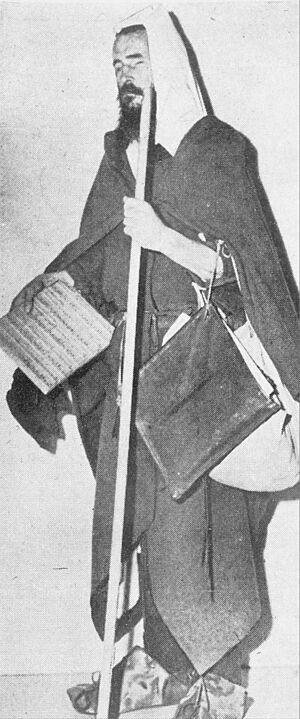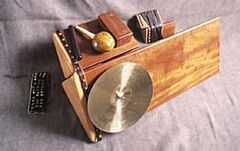Moondog facts for kids
Quick facts for kids
Moondog
|
|
|---|---|

Moondog in 1948
|
|
| Background information | |
| Birth name | Louis Thomas Hardin |
| Born | May 26, 1916 Marysville, Kansas, U.S. |
| Died | September 8, 1999 (aged 83) Münster, Germany |
| Genres | |
| Occupation(s) |
|
| Instruments |
|
| Years active | 1932–1999 |
| Labels | |
Louis Thomas Hardin (born May 26, 1916 – died September 8, 1999) was an American composer, musician, and poet. He was known by his stage name, Moondog. He taught himself most of what he knew about music. His unique style was inspired by jazz, classical music, and Native American music. He also loved Latin American music.
Moondog's music had strong rhythms and layers of sound. It later influenced famous composers like Steve Reich and Philip Glass. When he was 16, Moondog became blind due to an accident. He lived in New York City for many years, often seen on Sixth Avenue. He would sell his music and poetry there. In the 1960s, he sometimes wore a cloak and a horned helmet. People in New York called him "the Viking of Sixth Avenue."
Contents
Life and Music Career
Early Years and Becoming Blind
Louis Thomas Hardin was born in Marysville, Kansas. His father was a minister. When he was five, Louis started playing drums he made from a cardboard box. His family moved to Wyoming. There, his father opened a trading post. One time, his father took him to a Native American Sun Dance. Louis sat on the lap of Chief Yellow Calf and played a tom-tom drum. He also played drums in his high school band.
On July 4, 1932, when Louis was 16, he found something in a field. He did not know it was a dynamite cap. It exploded in his face and made him permanently blind. After the accident, his older sister, Ruth, read to him every day. This helped him learn about philosophy and science. A book called The First Violin made him want to become a composer. Before this, he mostly liked percussion instruments. But after, he wanted to create music.
He learned music principles at schools for blind young men. He also taught himself to recognize sounds and compose music by ear. He studied with Burnet Tuthill at the Iowa School for the Blind. Later, he moved to Batesville, Arkansas. In 1942, he got a scholarship to study in Memphis, Tennessee. Even though he learned mostly by ear, he studied some music theory from braille books in Memphis.
In 1943, Hardin moved to New York. He met famous musicians like Leonard Bernstein and Arturo Toscanini. He also met jazz stars like Charlie Parker and Benny Goodman. Their fast and fun music influenced Moondog's later work. He often stood near the jazz clubs on 52nd Street. Jazz musicians knew him well. In 1947, he chose the name "Moondog." He said it was for a dog "who used to howl at the moon more than any dog I knew of."
Life in New York City
From the late 1940s until 1972, Moondog lived in New York City. He was a composer and poet. He often played music in midtown Manhattan. He usually settled on the corner of 53rd or 54th Street and Sixth Avenue. He was not homeless. He had an apartment in upper Manhattan. He also had a quiet place in Candor, New York, where he moved full-time in 1972. He earned money by selling his poetry, sheet music, and records.
Moondog was also known for his special "Viking" clothes. He wore them for a short time in the 1960s. He already had a beard and long hair. He added a Viking-style horned helmet. This was to stop people from comparing him to Christ or a monk. He had decided not to follow Christianity when he was a teenager. He became very interested in Norse mythology. He even had an altar to Thor at his country home.
In 1949, he went to a Blackfoot Sun Dance in Idaho. He played percussion and flute there. This brought him back to the Native American music he knew as a child. This Native music, along with jazz and classical music, shaped Moondog's sound. He also used sounds from his environment, like city traffic and ocean waves.
In 1954, Moondog won a court case. A radio DJ named Alan Freed had called his show "The Moondog Rock and Roll Matinee." Freed also used Moondog's song "Moondog's Symphony" as his show's theme. Moondog sued him for using his name. Musicians like Benny Goodman and Arturo Toscanini helped Moondog by saying he was a serious composer. Freed had to apologize and stop using the name "Moondog" on his show.
Moving to Germany
Moondog loved Nordic culture. He also thought of Germany as a special place. He moved there in 1974. He briefly visited the United States in 1989. This was for a special event called the New Music America Festival. He conducted the Brooklyn Philharmonic Chamber Orchestra. This made people interested in his music again.
A young German student named Ilona Goebel (later Ilona Sommer) helped Moondog. She helped him set up his music business. She also hosted him in her home, first in Oer-Erkenschwick, then in Münster. Moondog lived with Ilona's family. During this time, Moondog created hundreds of new songs. Ilona helped turn his Braille music into regular sheet music. Moondog lived in Germany for the rest of his life.
He passed away in Münster on September 8, 1999, from heart failure. He is buried at the Central Cemetery Münster. His tomb was designed by the artist Ernst Fuchs. Moondog recorded many albums. He also toured in the U.S. and in Europe, including France, Germany, and Sweden.
Moondog's Music Style
Moondog got ideas for his music from many different styles. His first songs were inspired by pow wow gatherings he went to as a child. Later, his music included influences from bebop (a type of jazz), swing, and rumba. He also used ideas from modern and Renaissance music.
He called his unique rhythm "snaketime." He described it as "a slithery rhythm, in times that are not ordinary." He famously said, "I'm not gonna die in 4/4 time." In the 1950s, he started adding city sounds to his music. These included cars, subway trains, human speech, and foghorns.
Musical Inventions
Moondog invented several musical instruments. He played some of them on his albums and in live shows. Some of his inventions include:
- The "oo": a small, triangle-shaped harp.
- The "ooo-ya-tsu": a larger harp.
- The "hüs": a triangle-shaped string instrument played with a bow.
- "Dragon's teeth," "tuji," "uni," "utsu," "hexagonal drums," and the "troubador harp."
His most famous invention is the trimba. This is a triangle-shaped percussion instrument. Moondog invented it in the late 1940s. His friend and only student, Stefan Lakatos, played the original trimba. Stefan also learned how to build these instruments from Moondog.
Moondog's Influence
Moondog's music from the 1940s and 1950s greatly influenced other American composers. Philip Glass and Steve Reich said his work was very important to them. They understood and liked it much more than what they learned at the Juilliard School, a famous music school.
Other famous musicians admired Moondog too. These include jazz legend Charlie Parker, who Moondog honored with his piece "Bird's Lament." Frank Zappa and Igor Stravinsky also admired him. Moondog also met famous writers like Lenny Bruce, William S. Burroughs, and Allen Ginsberg.
Many musicians have dedicated songs to Moondog:
- "Moondog" by Pentangle (1968)
- "Spear for Moondog" by jazz organist Jimmy McGriff (1968)
- Marc Bolan and T. Rex mentioned him in their song "Rabbit Fighter."
- The English band Prefab Sprout included a song called "Moondog" on their 1990 album.
- Big Brother and the Holding Company with Janis Joplin covered his song "All Is Loneliness" (1967).
- Mr. Scruff's song "Get a Move On" uses parts from Moondog's "Bird's Lament."
- The band The Insect Trust covered Moondog's song "Be a Hobo."
Moondog also inspired a series of Underground comix in the 1970s. He was the main character. Several professional wrestlers have also used the name The Moondogs.
Personal Life
Moondog was briefly married to Virginia Sledge from 1943 to 1947. In 1952, he married Mary Suzuko Whiteing. She was a single mother from Japan. They met in New York City. Mary was impressed by Moondog's appearance and music. Moondog liked the sound of her voice.
A newspaper article from June 1952 showed Moondog playing a flute for Mary on a rooftop. It called it a "skyline serenade" for a "June bride." Their marriage lasted eight years. They had one daughter, June Hardin, born in 1953. On Moondog's 1956 album, his wife Suzuko sings a lullaby to their baby daughter, June. Moondog later had another daughter, Lisa Colins.
Discography (Selected)
Albums
- 1953 Moondog and His Friends, Epic
- 1956 Moondog, Prestige
- 1956 More Moondog, Prestige
- 1957 The Story of Moondog, Prestige
- 1969 Moondog, Columbia
- 1971 Moondog 2, Columbia
- 1992 Elpmas, Kopf
- 1994 Sax Pax for a Sax with the London Saxophonic, Kopf/Atlantic
Performed by Other Musicians (Selected)
- 1967 "All Is Loneliness" by Big Brother and the Holding Company, featuring Janis Joplin
- 1968 "Moon Dog" by Pentangle
- 1990 "Moondog" by Prefab Sprout
- 1999 "Get a Move On" by Mr. Scruff (uses samples from "Bird's Lament")
- 2023 Songs and Symphoniques: The Music of Moondog by Kronos Quartet and Ghost Train Orchestra
Images for kids






